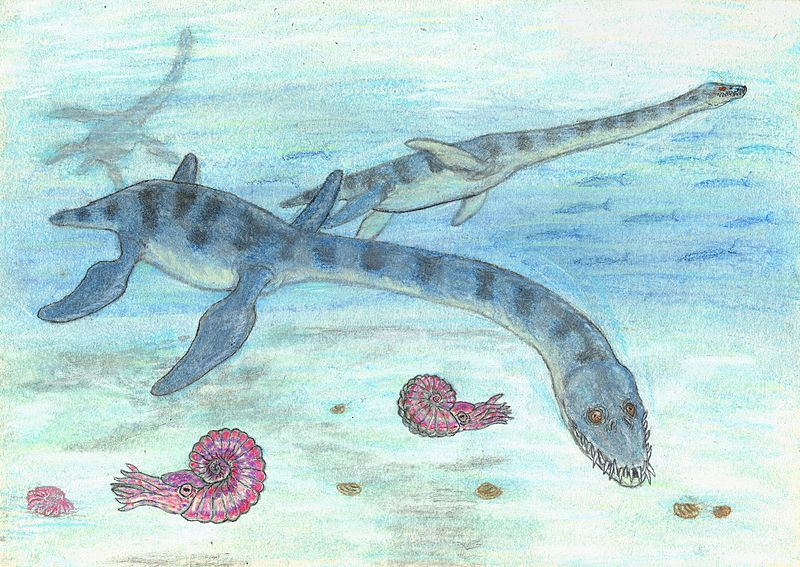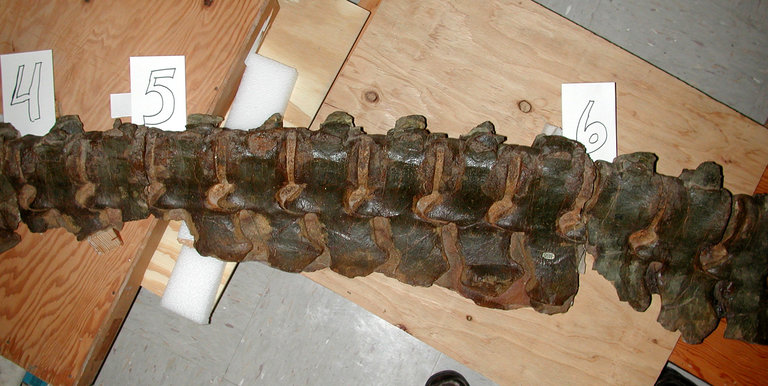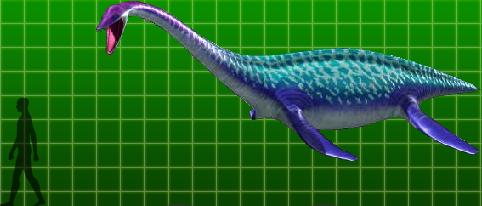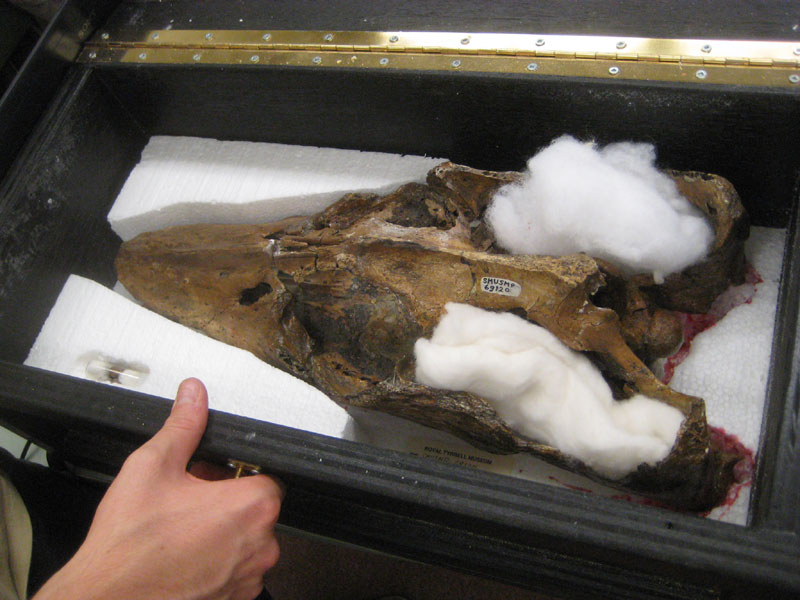[Recent Entries][Archive][Friends][User Info]
December 31st, 2013
| December 31st, 2013 | |
|---|---|
| 03:27 pm [industrialterro] [Link] |
Callawayasaurus Callawayasaurus is a genus of plesiosaur from the family Elasmosauridae. When the first Callawayasaurus fossil was first discovered by Samuel Paul Welles in 1962, he described it as Alzadasaurus colombiensis before it was moved into its current genus by Kenneth Carpenter in 1999. Callawayasaurus (Callaway) is named in honor of the paleontologist, Jack M. Callaway, editor of Ancient Marine Reptiles who, as Carpenter put it, "in his brief career as a vertebrate paleontologist, did much to improve our understanding of marine reptiles". The familiar suffix, -saurus comes from the Greek sauros (σαυρος), meaning "lizard" or "reptile". The first skull of Callawayasaurus to be found was 35 cm long, while the animal as a whole grew up to 8 m long. The nares of Callawayasaurus are elongated and positioned over the maxilla, which has 3-5 teeth. The neck contains 56 vertebrae which are relatively short compared to other elasmosaurids. Callawayasaurus fossils have no pectoral bars; in common with other plesiosaurs such as Terminonatator. They also lack postaxial accessory facets. Another nearly complete skeleton was found to be slightly more robust than the holotype specimen. This subtle change may indicate sexual dimorphism. The fist Callawayasaurus remains were found in the Paja Formation near Leiva, Boyaca Colombia. The species name for the type, "columbiensis", means "from Colombia." Callawayasaurus are known from the Aptian faunal stage of the early Cretaceous period, which extended from 125 to 112 million years ago. Ископаемые останки (1, 2, 3, 4, 5): Tags: Вымершие рептилии, Мел, диапсиды, завроптеригии, лепидозавроморфы, плезиозавроиды, плезиозавры, эласмозавриды |
| Time | Event |
| 04:44 pm [industrialterro] [Link] |
Futabasaurus Futabasaurus is a genus of plesiosaur from the Late Cretaceous of Fukushima, Japan. Described and named in 2006, it was assigned to the family Elasmosauridae. The length was about 7 m, and the weight was about 3~4 tons. Long distance between the eye sockets and nostrils. Interclavicles and clavicles are fused and the anterior edge is bent. Relatively long upper arm. Slim thigh bones with a significant muscle scar. Futabasaurus suzukii was named from the family name of discover Suzuki, and futaba from the Futaba Group. The name "Futabasaurus" also appears in connection with a theropod dinosaur, also from the Late Cretaceous of Japan. However, this dinosaur was not officially named, so the dinosaur "Futabasaurus" is a nomen nudum when applied to this theropod. It is not the same as the plesiosaur named Futabasaurus. Futabasaurus is the first elasmosaurid found in Japan. The type species is F. suzukii. Many of the bones of the type specimen show apparent scavenging or predation by sharks. The first fossils of Futabasaurus were found in the Irimazawa Member of the Tamayama Formation, Futaba Group, Fukushima Prefecture, Japan, dating to the Inoceramus amakusensis zone of the early Santonian. The fossils were found by Tadashi Suzuki, a high school student around that time.
Размеры тела в сравнении с человеком: Tags: Вымершие рептилии, Мел, диапсиды, завроптеригии, лепидозавроморфы, плезиозавроиды, плезиозавры, эласмозавриды |
| Time | Event |
| 05:25 pm [industrialterro] [Link] |
Libonectes Libonectes (meaning "southwest swimmer") is an extinct genus of sauropterygian reptile belonging to the plesiosaur order. It is known from a single fossil specimen found in the Britton Formation of Texas, dated to the lower Turonian stage of the late Cretaceous period. The animal was very similar to the related Thalassomedon, though the structure of the neck vertebrae were different, with taller neural spines and longer supporting processes of the bone, and its nostrils were slightly closer to the tip of the skull. The skull of the type specimen is the best preserved elasmosaurid skull known. The specimen consists of the skull and neck, as well as gastroliths found along with the fossil. A shoulder girdle and flipper were also found but were apparently discarded at some point in the past. The specimen was originally named Elasmosaurus morgani by Welles in 1949, but it was reclassified in its own genus by Carpenter in 1997. Tags: Вымершие рептилии, Мел, диапсиды, завроптеригии, лепидозавроморфы, плезиозавроиды, плезиозавры, эласмозавриды |
| Time | Event |
| 05:39 pm [industrialterro] [Link] |
Mauisaurus Mauisaurus ("Maui reptile") is a genus of plesiosaur that lived during the Late Cretaceous period around 80 to 69 million years ago in what is now New Zealand. It was the largest plesiosaur, and perhaps the largest marine reptile in New Zealand waters at the time. Mauisaurus haasti is the only known species of the genus. A handful of specimens have been found, although only a few are well preserved and mostly complete. The only other established New Zealand plesiosaur, Tuarangisaurus keyesi, cannot be linked as a direct relative to Mauisaurus. Mauisaurus was similar to other plesiosaurs. It had a characteristically long neck, that grew up to 15 metres (49 ft) in length, more than half its total length. Mauisaurus' neck length makes it one of the top plesiosaurs with a large neck to body length ratio. In total, Mauisaurus grew to around 20 metres (66 ft) in length and was easily the largest plesiosaur in New Zealand waters. Like other plesiosaurs, it had a long slender body, with numerous vertebrae, allowing flexible movement. On its underside, Mauisaurus had two sets of large flippers. These aided in swimming at high speeds, but may have also allowed the plesiosaur to venture onto shorelines for short amounts of time. Mauisaurus was a carnivore, with sharp jagged teeth that would have been used to grip fish or squid. Mauisaurus remains have all been found in New Zealand's South Island, near Canterbury. Altogether, around seven Mauisaurus specimens have been found in the area, most in or around the Waipara River. One Mauisaurus fossil was even found battling a mosasaur from the New Zealand region. Mauisaurus gardneri was described in 1877, but was later found to be separate to Mauisaurus haasti and is now considered a nomen nudum. Mauisaurus gets its name from the New Zealand Māori mythological demigod, Māui. Māui is said to have pulled New Zealand up from the seabed using a fish hook, thus creating the country. Thus, Mauisaurus means "Māui reptile". Mauisaurus gets its scientific last name from its original finder, Julius Haast, who found the first Mauisaurus fossil in 1870. The specimen was then first described in 1874. Mauisaurus is one of the few New Zealand prehistoric creatures, and so, has had much publicity in the country. On 1 October 1993, a set of stamps was released to the general public. Although it depicted many other dinosaurs and prehistoric life, Mauisaurus was featured hunting fish on the $1.20 stamp. Tags: Вымершие рептилии, Мел, диапсиды, завроптеригии, лепидозавроморфы, плезиозавроиды, плезиозавры, эласмозавриды |
| Previous Day | 2013/12/31 [Archive] |
Next Day |



















